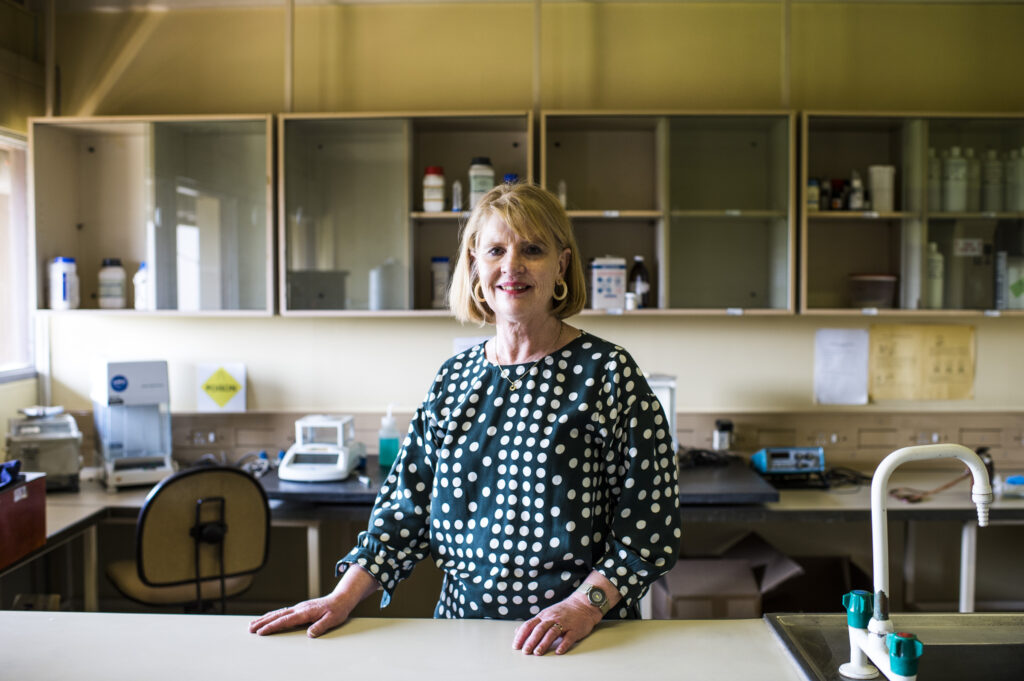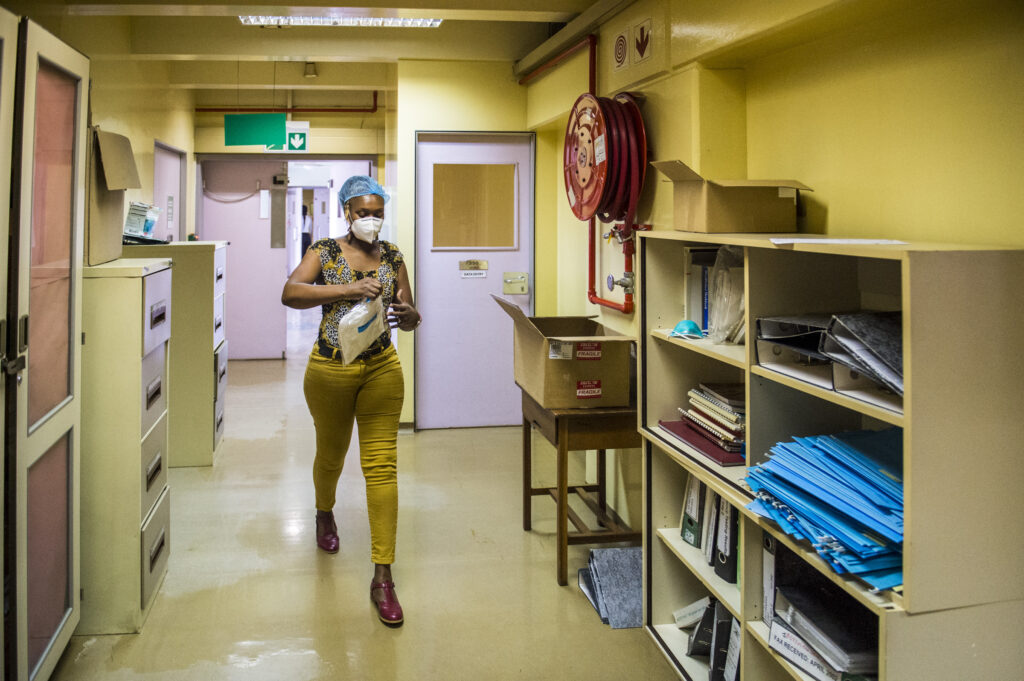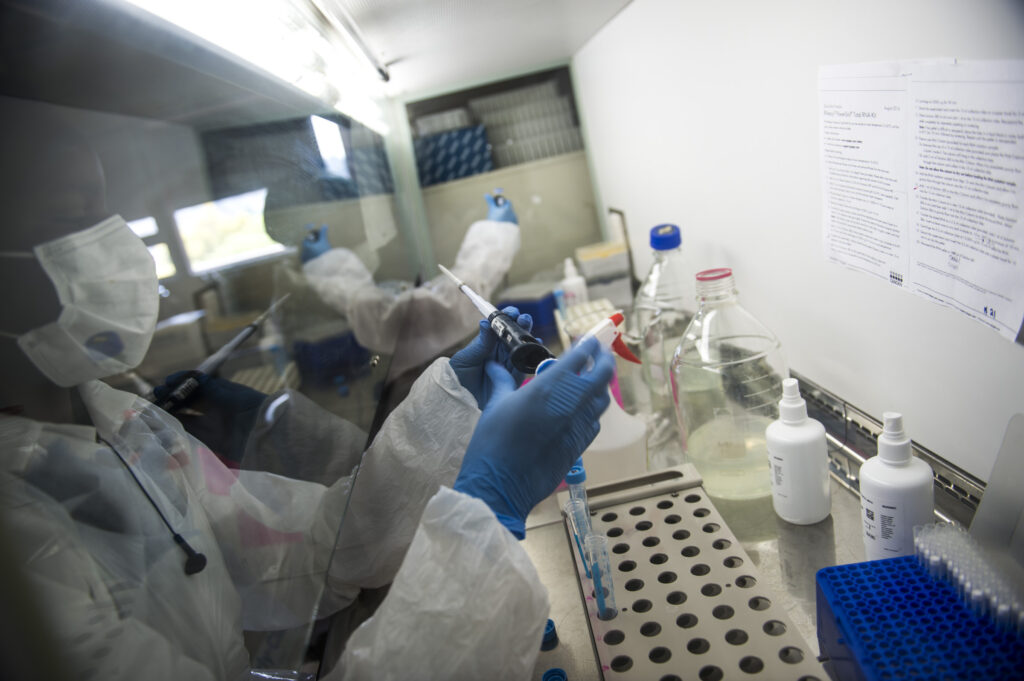There is a sanitation crisis In numerous informal settlements around South Africa. Photo: Sewage waste. Delwyn Verasamy/M&G
Dr Awelani Mutshembele swaps her red, genuine-leather flats for black gumboots and a full set of personal protective equipment (PPE), including goggles and a hair net. Normally she prefers high heels, even in the laboratory, but for sampling days she makes an exception.
“With the sewage plant I didn’t have a choice, I have to make sure I’m protected,” she says.
Mutshembele is a microbiologist and an intramural postdoctoral fellow at the South African Medical Research Council (SAMRC) although she usually works with the Tuberculosis (TB) Platform. For the past few weeks, she and her team have been testing samples from sewage-treatment facilities across Tshwane. The team is looking for traces of SARS-CoV-2, as part of their wastewater-based epidemiology, which is a way of monitoring the spread of diseases or chemicals through their presence in sewage.
Stationed near the entrance of the plant, Mutshembele and her team carefully dip a specially made ladle into the unpleasant-smelling river and fill up a row of 50ml test tubes. Mutshembele says the samples they collect come directly from the toilets after people have flushed. Although the experience is by no means pleasant, she is used to it by now.
It’s a Monday and people have been at home over the weekend, so she is excited and confident they will get some good results.
 SAMRC head Martie Van Der Walt. (Delwyn Verasamy/M&G)
SAMRC head Martie Van Der Walt. (Delwyn Verasamy/M&G)
Back to the lab
The team strips down into their ordinary clothes and heads back to the laboratory to don lab coats and start the long process of testing their sewage samples. They are looking for RNA, which is a nucleic acid, or genetic material similar to DNA and not the live or contagious virus.
The scientists go through a variety of steps to break open the cells and isolate the RNA. There’s a recipe-like instruction sheet for Mutshembele to follow as she expertly adds the reactant and times each session in the centrifuge.
Over several hours, the process finally results in just a few specks at the bottom of a test tube, which will be run through a quantitative polymerase chain reaction (qPCR) test to confirm if SARS-CoV-2 is present.
“So far, I love it this way,” Mutshembele says. The results of this sample are positive. But that isn’t surprising. During this process, the SAMRC team is defining a baseline or norm by matching the data from the sewage to positive Covid-19 test results in a particular area the sewage plants serve. Other factors, like rainfall and the larger movement of people, are taken into account.
 In science we trust: Dr Awelani Mutshembele and her team at the SAMRC have been testing sewage samples for Covid-19.
In science we trust: Dr Awelani Mutshembele and her team at the SAMRC have been testing sewage samples for Covid-19.
A ‘sewage snapshot’
“The importance of the work is, once the trend has gone down, you expect to have a continuously low level, which is then our new normal,” says Professor Martie van der Walt, the director of the SAMRC’s TB Platform, who is running the Tshwane wastewater-based epidemiology programme.
“Then, when you suddenly see a peak, you know that this may be a hotspot and there may be a mini outbreak happening in that specific area.”
Testing sewage is an alternative to testing patients directly. It isn’t dependent on whether someone tests for Covid-19, so the results aren’t influenced by stigma or the accessibility of tests. Mutshembele says that “the tool doesn’t need an invasion” and can be done anonymously at a large scale. It also picks up asymptomatic cases and isn’t reliant on whether someone feels particularly sick.
“The sewage will give you a snapshot of what’s going on in a community,” says Van der Walt. Essentially, everyone defecates, so everyone is included in this testing method.
The SAMRC has run a similar field sampling pilot in Cape Town and is training four partner universities around the country to do the same. Specialist scientist at the SAMRC’s environment and health research unit, Renée Street, says they found that the wastewater-based epidemiology results were similar to the testing results they had expected.
Importantly, the wastewater-based epidemiology results can pick up SARS-CoV-2 prevalence faster than other testing methods, which is one of the reasons why virus surveillance using sewage is so useful.

 The SAMRC team working with the sewage samples in the laboratory.
The SAMRC team working with the sewage samples in the laboratory.
Vital lead time
“The one- or two-week lead you get from what you find in the sewage could then help to prepare and to know where to put your resources, especially in resource-constrained areas,” says Street.
This system that the council is establishing is meant to inform the national department of health of the location of possible outbreaks. “Your public-health response needs to be appropriate for the level of disease in a community. We can’t always have the response that we have in a pandemic,” says Van der Walt.
There are still a lot of details to be determined in terms of how exactly responses such as increased testing and communication campaigns would be rolled out based on the wastewater-based epidemiology data. Yet, it is clear that it could prove very helpful, and has been so in other countries.
Although the main focus of this work is currently the SARS-CoV-2 virus, wastewater-based epidemiology has a long history of being used for other diseases, such as polio. Street says that they are already actively planning for detecting measles outbreaks and hope to start developing the methodology in the next few months. They would also consider other illnesses, such as hepatitis, in the future.
Supporting vaccine trials
Van der Walt says that the team also plans to use this method to provide support to vaccine-trial sites. The virus would be less prevalent in areas where the trial participants live, if the vaccine is working.
Other organisations are working on wastewater-based epidemiology projects around the country, and the SAMRC team works with them in a network to avoid duplication of research and foster collaboration.
However, this type of epidemiology does assume that people are connected to well-running sewage infrastructure, which isn’t the case for a significant number of South Africans.
“Soon we will be investigating that space,” says Street, adding that the SAMRC is thinking about the communities without sewage pipes and plans to research this next.
For now, Mutshembele and the team will return to the stinky business of collecting sewage samples, in the hopes that, in the long run, the data will help those flushing in ways they may never consider.